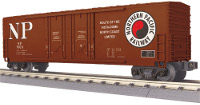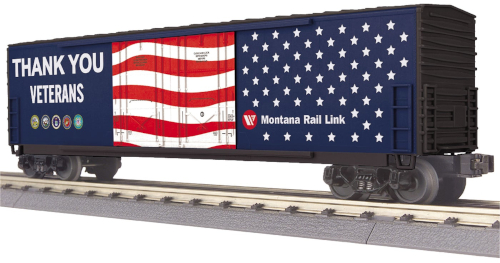
Information and Orders: 1-406-259-9004
Hours: Mon - Sat 10-6 MST
Central Hobbies
1401 Central Avenue
Billings, MT 59102
We Gladly Accept:

as well as

TRAINS : O-GAUGE ROLLING STOCK
- Page 1 of 3 | 36 Total Products

MTH 50’ Double Door Plugged Boxcar
Description:
While usually referred to as an insulated boxcar, the prototype for this car, according to the Association of American Railroads (AAR), is technically a bunkerless refrigerator car, class RBL. Built by Evans Products Company at Blue Island, Illinois from 1969-1977, these cars were designed for shipments that need protection from temperature extremes but do not require refrigeration. They have hardwood floors and at least 3” of insulation in their sides, ends and roofs. Produce is a common cargo. The cars’ length and wide 16’ door openings have also made them popular with plywood and lumber shippers.
In contrast with typical sliding doors, the plug doors on these cars are pulled into the door opening when the door is latched. This produces a nearly watertight and airtight seal, protecting the load and helping to keep a more constant inside temperature. A cushioned underframe also helps protect the load from shock, hence the “DF” (for “damage free”) logo found on some of these cars.
Evans Products built nearly 4.400 of these cars, selling or leasing them to a large number of North American railroads and private owners. Although the last of these cars are nearing the end of their allowable 40-year service life, they can still be found in U.S. freight trains today.
High quality, traditionally sized RailKing Freight Cars provide detailed bodies and colorful paint schemes for the O Gauge railroader. MTH makes an enormous variety of RailKing Freight Cars, including many different car types and roadnames. No matter what era or part of the country you are modeling, RailKing is sure to have something for you.

Our Price: $43.99

MTH O Gauge RailKing Crane Tender Car
Description:
The crane tender had two jobs: to protect the crane's boom and enable it to be coupled with other cars on the way to a wreck site, and to carry the tools, chains, slings and other gear needed to clear a wreck. Unlike the crane itself, which was a precision piece of gear made by a specialized company, the crane tender was usually a home-built affair, cobbled together from whatever a railroad's shop crew had lying around. Our model represents a typical such car, built from an older flatcar and part of an obsolete or wreck-damaged outside-braced wooden box car, now functioning as an equipment shed.
Intricately Detailed, Durable ABS Body. Internal Light in Cab
Metal Wheels and Axles
Die-Cast 4-Wheel Trucks
Fast-Angle Wheel Sets
Needle-Point Axles
(2) Operating Die-Cast Metal Couplers
Operating Interior Lighting
Detailed Brake Wheel
Near-Scale Proportions
Unit Measures: 11 1/2" x 2 5/16" x 4"
Operates On O-27 Curves
Our Price: $59.95

MTH O Scale Premier 40’ Steel Sided Reefer Car
Description:
40’ Steel Sided Reefer Car - Northern Pacific
This product is compatible with all O Gauge 3-Rail track systems including those systems offered by Atlas and Gargraves and Lionel and Ross Custom Switches.

Our Price: $74.95

MIKES TRAIN HOUSE O Gauge RailKing BOXUM MELONS Reefer Car
Description:
The coming of the railroad changed the way America ate and drank. Before the iron horse connected every town of any importance to the outside world, most food was grown or produced locally. The arrival of cheap, fast, refrigerated transport in the form of the woodsided reefer with ice bunkers at each end — enabled local brewers, dairies,
meat processors, and other food businesses to become players on a national scale. Among other things, the reefer enabled Chicago to become “Hog Butcher for the World”; in pre-reefer days, livestock had been transported to local markets and butchered as close as possible to the final consumer.
In the 19th Century, ice for reefers was harvested from frozen ponds each winter and stored as well as possible in insulated icehouses. The advent of mechanical ice making around 1900 greatly increased the capacity of the reefer fleet, which at its height consumed over on e million tons of ice annually. Since loaded cars needed to be re-iced about once per day, icing stations were erected around the country on shipping routes that could be as long as coast-to-coast.
Famed railroad historian John H. White referred to reefers as “the most conservative of all American freight cars,” as reefers retained wood frames and sides long after other types of cars had converted to steel construction. Steel reefers like this RailKing model became common only after 1940, and many wood reefers ran well into the 1960s. Mechanical reefers, with self-powered refrigeration units in each car, became the norm in the second half of the 20th century, and the practice of stopping a train to re-ice during shipment gradually disappeared.
- Intricately Detailed Durable ABS Body
- Metal Wheels and Axles
- Die-Cast 4-Wheel Trucks
- Operating Die-Cast Metal Couplers
- Colorful, Attractive Paint Schemes
- Decorative Brake Wheels
- Fast-Angle Wheel Sets
- Needle-Point Axles
- Opening Car Doors
- Unit Measures: 11 1/2” x 2 3/8” x 2 5/16”
- Operates On O-27 Curves

Our Price: $64.95

Lionel O Scale Northern Pacific RBL #98583
Description:
Grow your consist with this Standard O RBL!
.jpg)
Our Price: $69.99

Lionel Great Northern Flatcar w/ Covered Load
Description:
Shipping cost will vary by dimensions or weight please call or email for shipping quotes.
Made in USA of US and Imported Parts
Die-cast metal sprung trucks and operating couplers
Removable load on flatcar decks
Gauge: Traditional O Gauge
Dimensions: Length: 11”
RailLine: Great Northern
Minimum Curve: O-27

Our Price: $69.99

MTH O Gauge RailKing 50’ Double Door Plugged Boxcar
Description:
High quality, traditionally sized RailKing Freight Cars provide detailed bodies and colorful paint schemes for the O Gauge railroader. MTH makes an enormous variety of RailKing Freight Cars, including many different car types and roadnames. No matter what era or part of the country you are modeling, RailKing is sure to have something for you.

Our Price: $59.95

LIONEL O GUAGE BURLINGTON NORTHERN STANDARD O 50' BOXCAR #21
Description:
Scale in size but simplified in detail, the return of these Standard O freight cars offers an affordable way to build up your freight trains!

Our Price: $44.99

ATLAS O TRAINMAN 40' STOCK CAR GREAT NORTHERN
Description:
Separately applied roof walks, ladder, brake wheel & brake lines
Accurate painting & lettering
See-through roof walks
Metal couplers and sprung die-cast trucks
True scale dimensions with accurate details
Weighted, detailed underframes
2-rail cars feature scale wheels and body mounted scale couplers

Our Price: $68.95

MTH O Gauge RailKing Operating Box Car w/Signal Man
Description:
Features: Proto-Sound 2.0 With The Digital Command System Featuring: - Durable ABS Intricately Detailed Bodies - Metal Wheels and Axles - Die-Cast 4-Wheel Trucks - Operating Die-Cast Metal Couplers - Colorful, Attractive Paint Schemes - Decorative Brake Wheels - Fast-Angle Wheel Sets - Needle-Point Axles - Operates On O-27 Track - Sliding Car Doors Unit Measures

Shipping cost will vary by dimensions or weight please call or email for shipping quotes.
Our Price: $29.95

MTH O Gauge RailKing Flat Car w/40’ Trailer
Description:
Flat Car w/40’ Trailer - Montana Rail Link (Veterans)

Our Price: $69.95

O-line Reproductions O gauge Stock Car CB&Q #646054
Description:
10 1/4 inches long
.jpg)
Our Price: $29.95
- Page 1 of 3 | 36 Total Products
